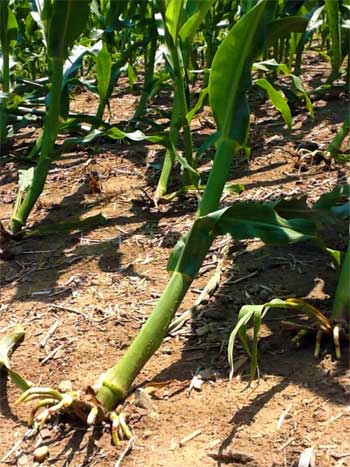Wind damage in your corn field
Recent storms knocked down some corn in fields. What will the long term effects be?
|
Mid-Michigan received some welcome rain on July 5th, but it came with a price. High winds caused “flattened” corn in some fields.
Corn in the vegetative and early reproductive stages can be impacted by high winds in two way; green snap or root lodging. Green snap is when the corn stalk snaps off at one of the nodes. Root lodging occurs when the corn plant is pushed over and the roots are pulled from the grounds or broken. Both conditions have the potential to impact yield, but the extent is dependent upon many circumstances.
Green snap
Emerson Nafziger, a professor at the University of Illinois, says that the yield effects of green snap is dependent on the number of plants snapped and where the breakage takes place. If it breaks the node just below the ear, dormancy will break and allow the next ear to develop, however, this ear may produce fewer kernels due to decreased pollen. If the stalk breaks near the ground, no ear will be produced. It appears that green snap was not the primary damage in this storm.
Root lodging
With root lodging, the field may appear as if it was “steam-rolled,” or random stalks will be flatted or tipped. Flattened plants suffer a disruption of the root system and disorientation of the leaves. If the corn is at the pollination stage, when maximum photosynthetic rates are needed to assure successful pollination, the impact can be negative according to Nafziger. However he states, “Most cases of root-lodging before pollination that I’ve seen have usually ended up causing less yield loss than expected.”
Soon after the storm, the damaged field will look its worst – give the field several days to recover. The picture below shows a corn in the V6 stage that was flattened by the July 5th storm. By noon, July 6th, just 33 hours after the storm, the corn is already tipping upward.
We will not know the true impact of wind damage until after harvest. In addition to the potential loss due to corn development being disrupted, we may also see losses at harvest due to “goose necking” making harvest more challenging.
Resource for this article: “Wind damage in corn,” University of Illinois.



 Print
Print Email
Email



